The Golf GTI story reads like the biography of a rock legend. It starts with enthusiasm and experimentation, then explodes into unimagined success. Before long, our hero is a household name. After that come the wilderness years: losing focus and getting fat as once-loyal fans go elsewhere. Finally, there’s the critically-acclaimed comeback, supported by strong sales and the status of an ageing icon.
That’s the familiar narrative, but it’s not the whole story. The GTI saga now runs to eight chapters stretched over 49 years – and it looks set to outlive any wizened guitar god. But I’m focusing on the first three generations, from the mould-breaking Mk1 to the middle-aged Mk3. At the time of writing, all these cars belonged to James Bullen, whose collection also numbers several Porsche 911s. Yet the less exalted German Sportwagens are just as capable of lighting his fire.
Back to the beginning. In 1975, the Mk1 Golf GTI made more noise than Johnny Rotten. What started as the ‘Sport Golf’ – a weekend project for a group of VW motorsport engineers – debuted in concept form at the Frankfurt Motor Show. Five thousand cars were planned for Group One Touring Car homologation, but overwhelming demand saw production ramped up tenfold, from 50 cars a day to 500. GTI mania was in full swing and Volkswagen couldn’t build enough of them.

A right-hand-drive GTI didn’t reach Britain until 1979, when its rivals included the Renault 5 Alpine and Lotus Sunbeam. But the 1980s were just around the corner and the golden age of the hot hatchback would soon dawn. By the time the Mk1 bowed out in 1983, the Ford Escort XR3 and Vauxhall Astra GTE had hit showrooms, while the Peugeot 205 GTI was months away. Volkswagen needed a riposte, and it came with the 1984 Mk2 GTI.
Far from being the ‘difficult second album’ the Mk2 built on the strengths of its predecessor. It had a more rounded and aerodynamic design (Cd 0.34, versus 0.40 for the Mk1), longer-travel suspension, better brakes, a roomier interior and improved rust protection. In 1988, the GTI – now boosted by a potent 16-valve version – was the best-selling Golf in the UK, shifting more than 11,000 units that year. Sadly, TWOCing, joyriding and the nascent Max Power culture would change all that.
By 1992, the hot hatch was under siege. Insurance premiums had soared and many buyers turned to compact SUVs like the Suzuki Vitara and soon-to-be-launched Toyota RAV4. The Mk3 thus flew under the radar, bereft of red stripes, jazzy seat fabrics or even the trademark golf ball gearknob. Like John Lydon making butter advertisements, the GTI seemed to have sold out.

The Mk3 was controversial for other reasons, too. Around 180kg of added weight – partly due to new safety equipment such as side-impact bars – seriously blunted performance. Its damping was also criticised for being too soft: tuned for comfort, rather than B-road fun. Volkswagen again responded with a 16-valve version, plus the new Golf VR6, but the Mk3 never shook its reputation for mediocrity.
Until now, perhaps? Teeing off with the legendary Mk1, I’ll be driving all three GTIs back-to-back. Which is simply par-for-the-course and which is a hole-in-one? That’s quite enough golf puns. Fore!
Volkswagen Golf GTI Mk1

I owned a string of Mk1 GTIs in my youth, so this feels like plunging into a warm bath of nostalgia. The four horn buttons, the square dials, the slightly synthetic smell: it’s all instantly familiar. Even the long, notchy shift from second to third seems lodged in my muscle memory. But the tatty bolsters and damp carpet I recall are notably absent here. James’s concours-winning GTI Campaign is absolutely flawless.
The GTI debuted in 1975 with a 110hp 1,588cc engine and four-speed manual ’box – both borrowed from the Audi 80 GTE (‘E’ stood for einspritzung, German for injection, but Volkswagen anglicised it). Its handling benefited from stiffer springs and dampers, a 20mm lower ride height, anti-roll bars and 13-inch alloy wheels, while braking was beefed up with ventilated front discs and a stronger servo. Zero to 62mph took 9.0 seconds, while top speed was 112mph.
UK buyers joined the party in 1979, when the car also gained a five-speed gearbox. A What Car? group test pitched the Golf against a Ford Escort RS2000, Talbot Sunbeam Ti and Vauxhall Chevette HS, declaring the German the clear winner. In 1982, the GTI’s engine was bored and stroked to 1,781cc, offering a paltry gain in power (up 2hp to 112hp) but usefully more torque. The 0-62mph sprint tumbled to 8.2 seconds, with 114mph possible on the autobahn.
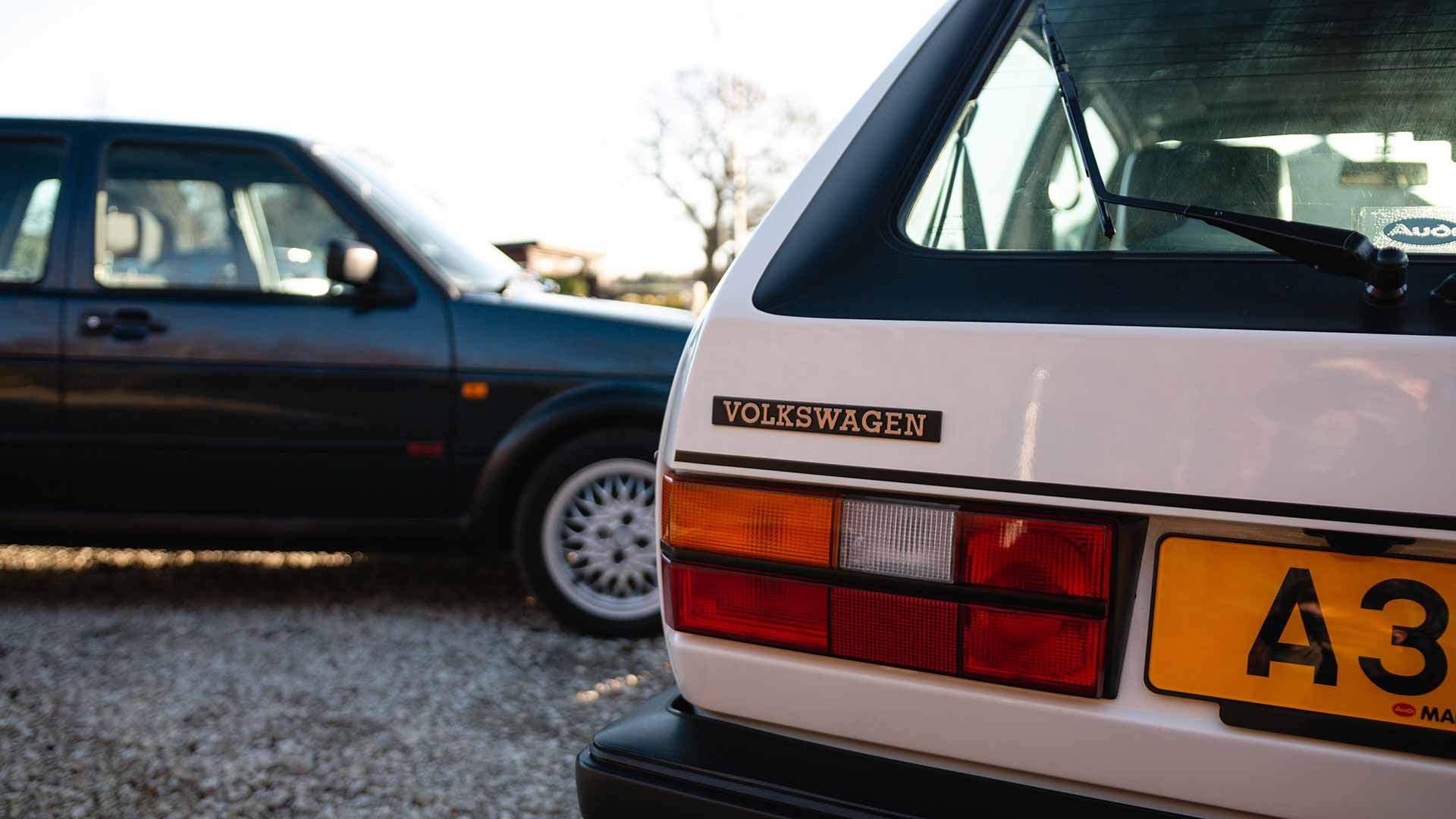
The run-out Campaign edition signalled the winding down of Mk1 GTI production in 1983. One thousand cars were allocated for the UK, and they are highly sought-after today. Factory-fitted extras included a sunroof, twin-headlamp grille, green-tinted glass and leather-trimmed steering wheel, plus distinctive 14-inch Pirelli ‘P-slot’ alloys. By the time the final Campaign departed Wolfsburg, more than 400,000 GTIs had been sold.
Perhaps I’m biased – OK, I am biased – but I’d rate the Mk1 Golf a score-draw with the Peugeot 205 as the best looking hatchback ever. Nearly five decades later, Giugiaro’s crisp, ‘folded paper’ styling (see also the BMW M1, Lotus Esprit and original Fiat Panda) still looks fresh. Volkswagen deliberately downplayed the GTI’s performance, couching it as a safety feature, but a jutting front spoiler, plastic wheelarch extensions and, of course, that red pinstripe, helped set it apart. Nobody could mistake this for a lowly Golf L.
Contrary to urban myth, only the earliest Mk1s had ‘Jacara’ tartan trim (famously resurrected in 2004 for the Mk5 Golf GTI). Most used the striped seats seen here, which add some colour to an otherwise staid cabin. Its USP was one of the first trip computers, activated via a switch atop the column stalk. Frankly, my ‘MFA’ never worked, but the LCD screen in James’s car duly cycles through oil temperature, fuel consumption, average speed, journey time and more. It’s infotainment, 1983-style.

I twist the key and the GTI barks brusquely into life. Its unassisted steering needs muscle to manoeuvre and its gearbox is downright stubborn when cold, but the throttle feels eager and instantly responsive. Thank a kerb weight of just 840kg, versus 1,463kg for the current, eighth-generation GTI. In contrast to the revvier, shorter-geared 1.6 engine, the 1.8 does its best work in the mid-range, punching hard out of apices with a blustery roar. Try hard enough and you’ll even lift an inside rear wheel.
No, the Golf can’t match the epochal 205 GTI for fingertip delicacy, yet it still feels joyously feisty. The suspension relays every ripple in the road, the steering jostles with feedback and the front tyres cling on tenaciously, then succumb safely to understeer. Only the brakes – a notorious Mk1 shortcoming – demand a cool head and a firm right foot. The thought of binning James’s pride and joy is too much to bear.
This was never going to be a rational review, but I’m manfully resisting the urge to award victory to the Mk1 right away. After all, I still have two Golfs left to drive. The game is on…
Volkswagen Golf GTI Mk2
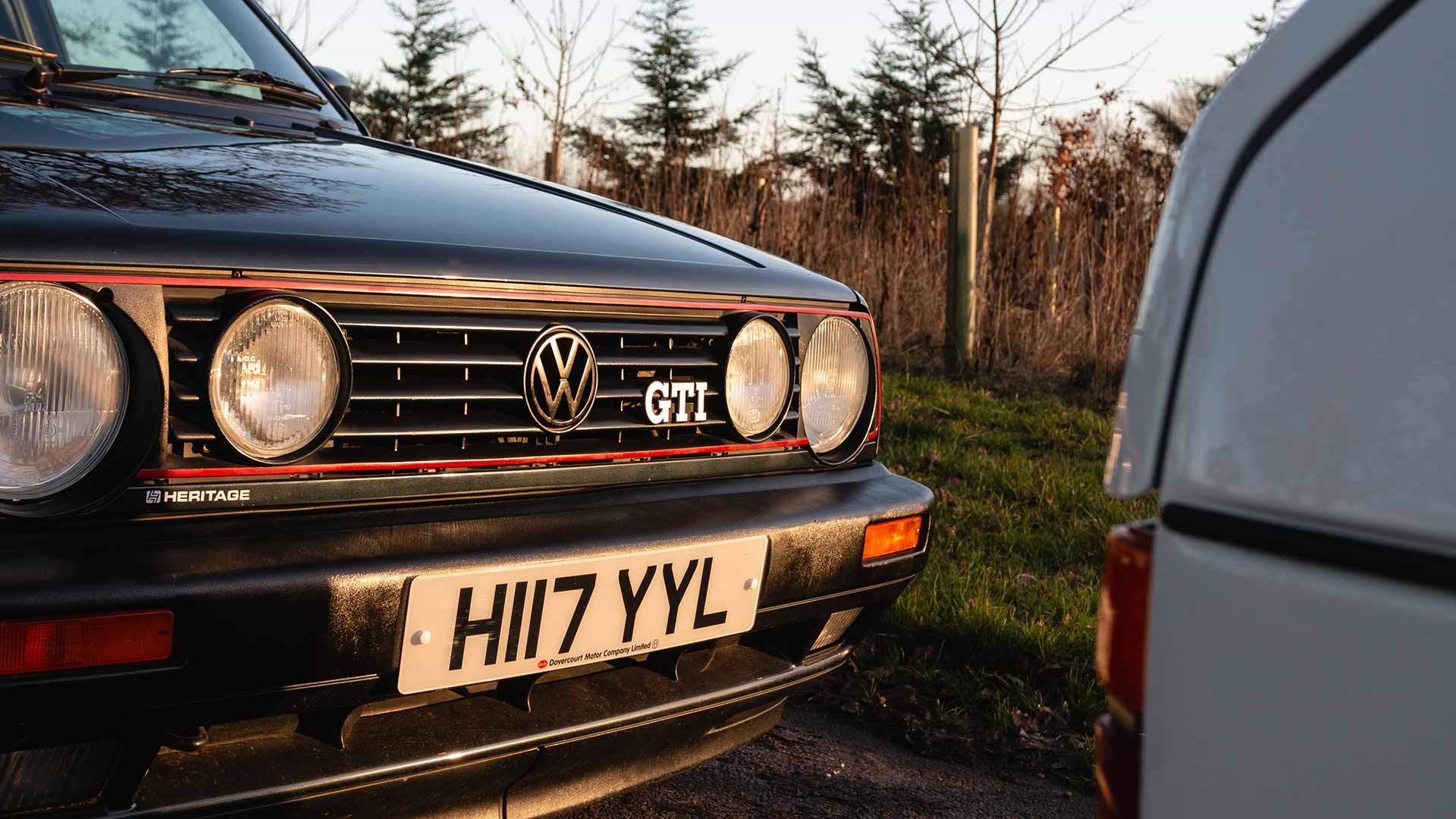
After restoring his Mk1 to better-than-new condition, James wanted a new challenge. A Mk2 project was the logical next step, and this 1991 GTI – cosmetically imperfect, but gloriously original – ticked every box. With one fastidious owner from new and a fully-stamped VW service history, it’s the kind of retro car we all dream of unearthing.
If the Mk1 was a punk pioneer, this was the sophisticated New Wave. It refined an existing recipe, then spiced it up like never before. Launched in 1983 with the familiar 112hp eight-valve engine, the Mk2 GTI swiftly gained a 139hp 16v sibling, followed by the 160hp Golf Rallye – a homologation special with box wheelarches, a supercharged G60 engine and four-wheel drive. Finally, the near-mythical 210hp Golf Limited combined sleeper styling with a 16v G60 motor. Just 71 were hand-built by Volkswagen Motorsport.
Back in the real world, the new Golf was 170mm longer, 56mm wider and appreciably roomier inside. A five-door version enhanced practicality and power steering was offered for the first time. Its bodywork was better protected (a six-year corrosion warranty was standard) and improved aerodynamics helped offset the 80kg of extra weight. Indeed, VW quoted a 2.1mpg gain in fuel economy, plus a 5mph higher top speed. The GTI 8v now managed 0-62mph in 8.3 seconds and 119mph.
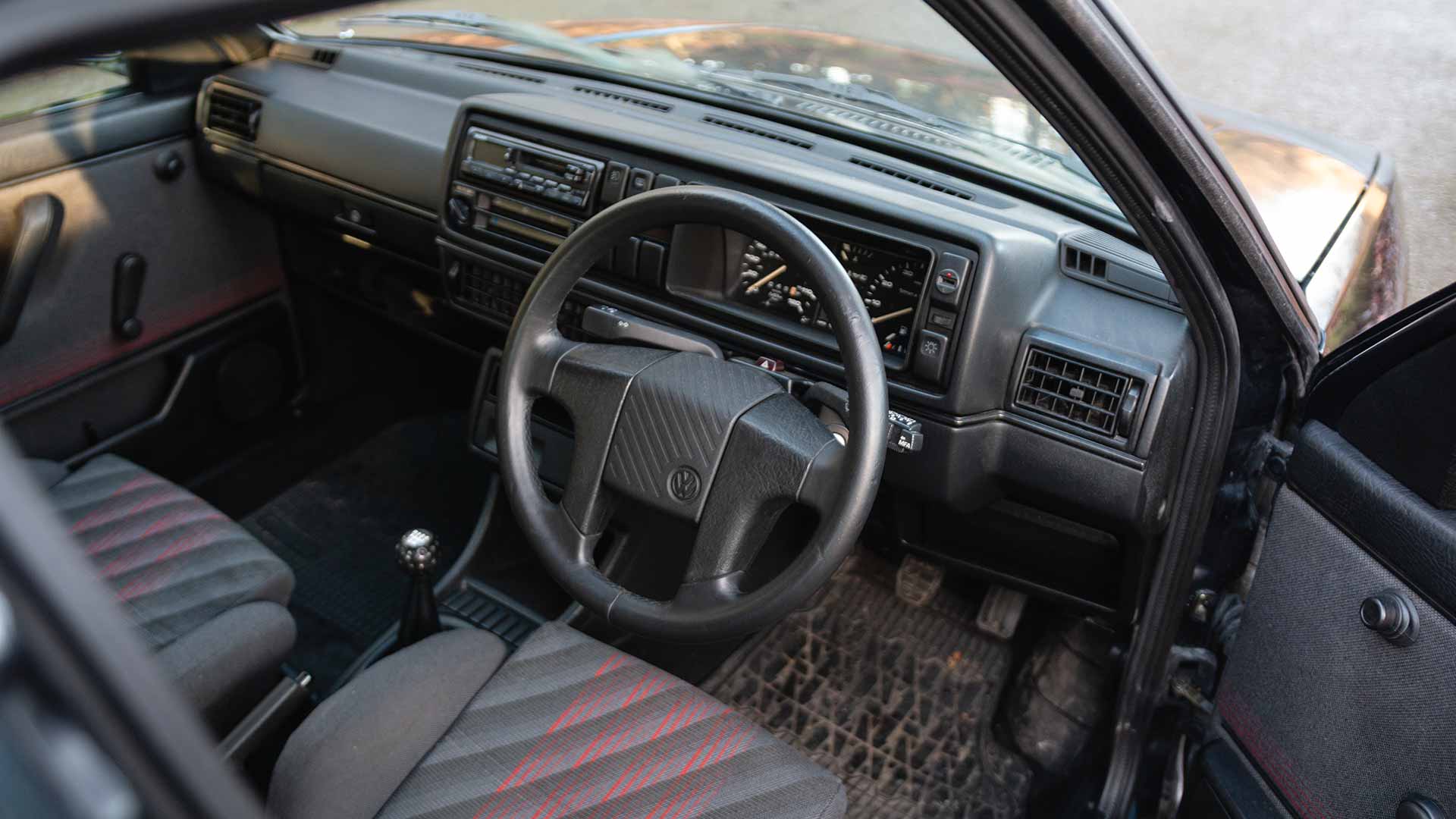
The result was a huge hit. The Golf’s upwardly-mobile image chimed with the zeitgeist, and nearly one in three Mk2s sold in Britain was a GTI, despite a price tag some £1,000 higher than the Astra GTE. Updates during the car’s life included Bosch Digifant electronic injection, which replaced mechanical K-Jetronic for 8v cars from 1988, plus painted ‘big bumpers’ from 1990. The Mk2 was phased out a year later.
In-house designer Herbert Schäfer chamfered off Giugiaro’s crisp creases, but the Golf DNA – from snub snout to chunky C-pillar – is still readily apparent. Still not everyone was happy: ‘The new Golf doesn’t look exciting. It doesn’t look different,’ complained Road & Track magazine at the time. The Mk2 also carried over the GTI’s go-faster visuals, adding red badges on the rubbing strips and twin tailpipes. The cross-spoke BBS-style alloys fitted to James’s car look period-perfect, too.
The Mk2 GTI brochure boasts of a ‘body-hugging driver’s seat’ and ‘comprehensive array of instruments’, yet its austere cabin looks little different to the Mk1. The steering wheel is still fixed, the instrument panel is near-identical save for a new font, and the heater controls are simple sliders. The MFA trip computer also makes a comeback. The real point of difference here is quality. The Mk2 has a built-to-last solidity common to most German cars of this era. With 44,000 miles on the clock, James’s car feels barely run-in.

This aura of over-engineering is heightened on the road. Longer spring travel gives the Mk2 a more settled ride than its parent, while its brakes – now discs at the rear, rather than drums – offer much more bite. A wider track and stiffer chassis mean the older car’s scrappyness at the limit is banished, too. The 1.8-litre engine revs eagerly and the GTI feels impressively fast and forgiving. You can drive like a hooligan (as many owners surely did) and it will look after you.
The price for such poise, though, is a little excitement. I loved the Mk2, but it didn’t make me grin as often as Das Original. On the right road, it doesn’t quite hit the same highs. I suspect if I drove a Mk2 regularly, my opinion might change – and this genuinely is a classic you could commute in. Not that this pampered example will face such an indignity.
Volkswagen Golf GTI Mk3
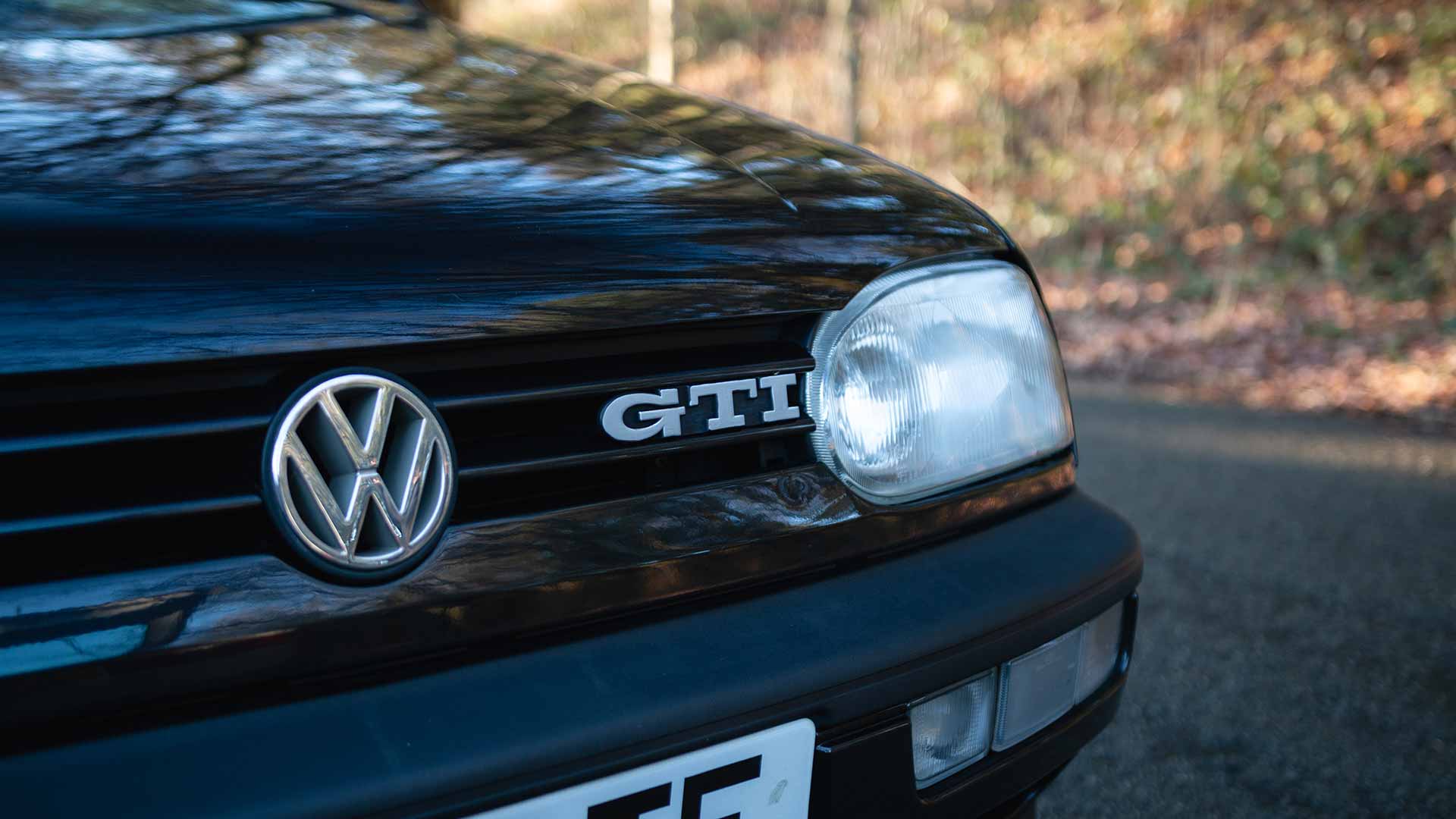
Let’s take a Tardis back to the 1991 Frankfurt Motor Show. Through a blizzard of dry ice, a cadre of moustachioed men, their names each prefaced by ‘Doktor’, unveil a new Golf to the waiting media. They talk of improved safety, highlighting crumple zones, door beams and optional front airbags. They wax lyrical about fuel economy, citing a 0.30 Cd and TDI diesel engines. And they stress how green this Golf is, with its 60 recyclable plastic parts.
Eventually, the new GTI breaks cover, but the former flagship is sidelined by the plush six-cylinder Golf VR6. Times have moved on since the go-getting 1980s, and the GTI’s halo has slipped. Even the VW execs seem slightly underwhelmed. A flick through the brochure says it all: six pages for safety, four for environmental issues and just two for ‘driving enjoyment’.
That the GTI’s 1,984cc engine also resides in (Europe-only) Highline models hardly helps. A bored and stroked version of the erstwhile eight-valver, it delivers 115hp and 122lb ft of torque at 3,100rpm. Sadly, those three additional horses have an extra 182kg (roughly two rugby players) to haul around. The Mk3 thus earns the dubious accolade of being the only GTI that can’t crack 62mph in less than 10 seconds. VW’s official stats are 10.3sec and 123mph.

Today, the notion of a new car being so much slower than its predecessor is unthinkable. As Germany’s horsepower battle blasts hot hatchbacks beyond 400hp, the chief engineer would surely be frogmarched from the premises. James is well aware of the Mk3’s shortcomings, yet he believes it gets an unfairly poor press. His timewarp 1996 8v GTI is another one-owner car, with superb service history and 58,000 miles from new. I resolve to keep an open mind.
The Mk3’s bar-of-soap styling wears its 30 years well. Its oval headlights, integrated bumpers and flush glass look contemporary, while its heavy haunches are amply filled by 15-inch alloys. Nonetheless, for a GTI, there’s a disheartening lack of pizzazz. Pry off the badges and you’d struggle to tell it apart from an everyman Golf. In an era of social responsibility and stratospheric insurance costs, perhaps that was the point.
The watering down of the GTI’s once-vibrant identity continues inside. Open the heavyweight door and the seat fabric looks subdued, while the golf ball gearknob gives way to a generic blob of black plastic. Still, it’s better appointed than the spartan Mk2, with an adjustable steering column and electric windows, plus the option of climate control air-con. Incidentally, the Colour Concept special edition threw sobriety to the wind, offering GTI buyers a choice of lurid green, red, blue or yellow paint, plus matching leather trim. It’s now a collectable curio.

Twist the key and the 8v engine immediately sounds more muted, while power steering takes the hard work out of those first few yards. Enclosed by a thick-set dashboard and broad roof pillars, it feels entirely like a modern car. In today’s terms, its performance is more ‘Golf GT’ than ‘GTI’, but the Mk3 isn’t the sluggard I’d feared. With a strong mid-range punch and snappy shift, it’s fast enough to be fun.
This Golf’s chief failing – in my eyes, at least – is how it handles. There’s an inertia, a reluctance to turn-in and hold its line, that the frisky Mk1 and deft Mk2 don’t share. Despite lively steering, its suspension feels too soft and slow-witted to fully engage with great roads. Instead of simply coaxing it into corners, you need to cajole it – and the rewards simply aren’t so great. Not quite what the Doktors ordered, then.
How much should you pay?

Andrew Chapple is a Volkswagen expert and journalist. His company, Volkswizard, always has a selection of quality Golf GTIs in stock. Here’s his verdict on what the first three generations of GTI are worth.
“An excellent Mk1 could cost £20,000, although the best cars have sold for much more. For something usable, you’ll pay less than half that: around £8,000. Just make sure all the original parts are present, as many are long obsolete and highly sought-after when they turn up for sale. As for a ‘project’ Mk1 GTI, you could find one for £3,000 or so. I wouldn’t recommend it unless you’re hands-on with body repairs, though – costs can mount up very quickly.
“Anything from £10,000 to £20,000 could net you a concours-winning Mk2. That said, many have been tarted up to sell, and low mileage is useless without a structurally sound shell. Look for a documented history with oil changes every 10,000 miles. A presentable car with 150,000 miles might cost you £3,000 and should drive OK. But paperwork is still desirable at this price to make any future restoration worthwhile.

“Corrosion can be a huge issue with cheap Mk2s, so tread carefully. Check the base of the windscreen, especially the area only visible with the front doors open where the sunroof drain tube resides.
“The Mk3 GTI is far more affordable. A really clean example might be £6,000 and – a bit more for an Anniversary model – and a usable car around £1,500. There’s a high rate of attrition, however. Even though they are younger than Mk2s, they started to rust much sooner, especially on the sill step where the door seal traps water. The rear of the front wheelarches is another problem area, as mud builds up there. Restoring a rust-ravaged Mk3 is uneconomic at present.”
Golf GTI group test: verdict
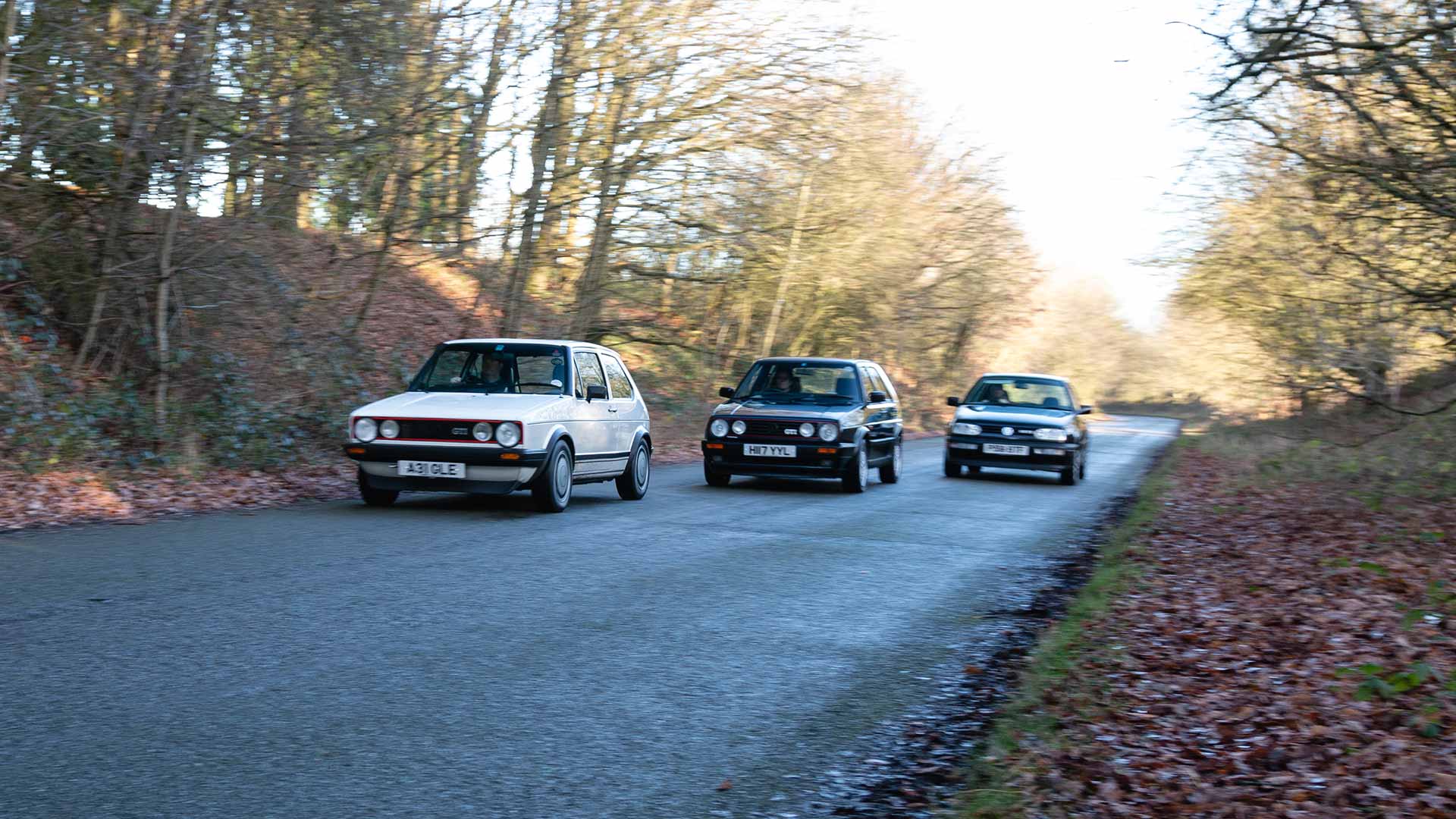
There’s no last-minute twist, no ‘and on that bombshell…’ The third-generation Golf finishes third, as expected. However, the Mk3 has its merits. It feels two generations removed from what came before: mature and reassuringly modern – particularly for those accustomed to newer cars. It’s also hugely more affordable than its ancestors, at roughly a quarter of what you’d pay for an equivalent Mk1. As a reliable and safe starter classic, it makes a strong case.
Equally – and this hardly feels like a valedictory flourish – the Mk3 is vastly better than what followed. The woeful 125hp Mk4 GTI, launched in 1997, abandoned all pretensions of sportiness, with an aloof chassis and yet more weight. It was a low-point, the Phantom Menace of the GTI saga. When the 2004 Mk5 GTI finally returned the car to its roots, enthusiasts the world over gave a collective sigh of relief.
As for picking a winner, that’s a trickier task. The Mk2 is a more complete car: easier to live with and objectively better. Good examples are more plentiful and cheaper to buy, too. But a classic car is ultimately about character and being fun to drive. And the iconic Mk1 GTI simply tugs at my heartstrings in a way its successor never will. There, I told you I was biased.
ALSO READ:
Volkswagen Golf GTI Mk8 review
Volkswagen K70: the story of a ‘quiet game changer’
Great Motoring Disasters: trying to replace the Volkswagen Beetle



[…] Classic Golf GTIs: driving Volkswagen’s hot hatch icons […]
[…] Classic Golf GTIs: driving Volkswagen’s hot hatch icons […]
[…] Johnson, now living in Montana in the USA, bought the now-classic Golf in 1987 while on a European […]